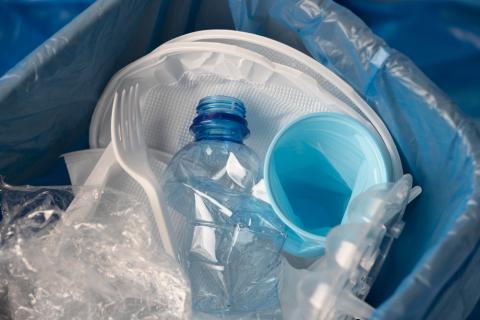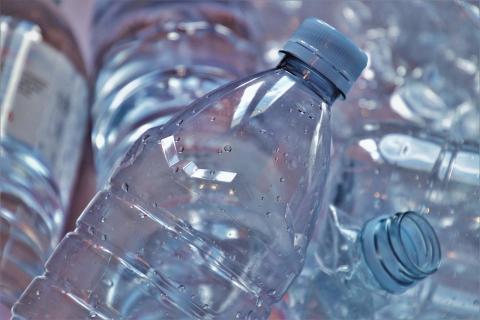Evidence on the toxicity of microplastics in the human brain and strategies for their elimination examined
An article reviews evidence on the accumulation of microplastics in human brain tissue recently published in Nature Medicine. The authors highlight practical measures to reduce exposure, noting that switching from bottled water to filtered tap water could reduce microplastic intake from 90,000 to 4,000 particles per year. The paper is a commentary in Brain Medicine.

Carlos Edo - plásticos cerebro
Carlos Edo
Researcher at the Danish Museum of Natural History at the University of Copenhagen
This is undoubtedly a very complex issue that requires careful treatment. Experts in the study of micro- and nanoplastics, such as Dr. Dusan Materic and Dr. Melanie Bergmann, have pointed out that certain techniques (specifically, pyrolysis coupled with gas chromatography, which is used in the article) can generate false positives due to, among other factors, the presence of fatty tissues in cellular matter. If sample preprocessing is not carried out properly or if the method has not been validated to ensure complete cleaning after digestion, there is a risk of obtaining inaccurate data. This happens because signals can appear that resemble those of polyethylene, considering that, ultimately, the compounds released are molecules and fragments with common structures (based on carbon, hydrogen, and oxygen) that can lead to this ‘coincidence.’
What seems clear, in general terms, is that the Nature Medicine article uses methods that leave room for doubt, in addition to presenting inconclusive images. Although they reflect the effort made by the authors, they also highlight the need for further work to fully convince us that what has been detected is indeed plastic and not cross-contamination. The detection of plastics at these size scales is an extremely complex analytical process and, currently, the urgency to publish information about their presence in remote locations (including the human body) may contribute to the appearance of such high-profile publications.
Undoubtedly, the scientific community has reacted to this study, and although the precautionary principle always takes precedence, it will be necessary to expand this work, obtain more reliable data, and thus be able to develop policies that truly help improve human health.
Ethel - plásticos cerebro
Ethel Eljarrat
Director of the Institute of Environmental Assessment and Water Studies (IDAEA-CSIC)
The article published in Brain Medicine reviews the latest scientific advances regarding exposure to microplastics (MPs) and their toxic effects, with a special emphasis on the need to find strategies to reduce exposure, whether through dietary changes or lifestyle modifications.
Humans are exposed to MPs through ingestion and inhalation. Putting an end to the practice of heating food in plastic materials is one way to reduce MP intake. Several studies highlight this issue, for example, when plastic tea bags are submerged in boiling water, when plastic baby bottles are sterilized, or when food is cooked in plastic containers in the oven or microwave. It is also important to explore possible ways to eliminate MPs once they have entered our bodies, such as promoting activities that induce sweating, like sauna sessions and moderate exercise.
The published work also addresses the main gaps in current research. From my point of view, we should stop classifying all MPs as a single pollutant, since the toxic effect of an MP will depend on several factors, such as its size (the smaller the size, the greater the toxicity), its shape, and most importantly, its content of toxic chemical additives associated with the plastic. Therefore, future research should not be limited solely to the potential physical effects caused by the presence of MPs in our bodies but should also focus on the chemical effects of the additives associated with them.
Finally, the study also highlights temporal trends, showing that MP levels in human samples increase exponentially over time. This is hardly surprising, given that global plastic production data also show year-on-year growth, which leads to increased plastic pollution in our ecosystems and, consequently, increased human exposure to MPs. These data underscore the urgent need to reach international agreements to cap plastic production.
Roberto Rosal - análisis microplásticos cerebro EN
Roberto Rosal
Professor of Chemical Engineering in the Department of Analytical Chemistry, Physical Chemistry and Chemical Engineering at the University of Alcalá
The commentary Human microplastic removal: what does the evidence tell us?, published in Brain Medicine, refers to a recent article in Nature Medicine (Brief Communication) and places it in the context of other worrying information on the possible impact of plastic pollution on human health. I refer firstly to the Nature Medicine article, Bioaccumulation of microplastics in decedent human brains, which reports very high concentrations of plastics in autopsied brains and suggests a possible link to the development of dementia. In my opinion, these findings are flawed for the following reasons:
- Inadequate methodology. The study uses pyrolysis coupled to gas chromatography with mass spectrometry detection (Py-GC-MS), a technique unsuitable for the analysis of biological matrices due to interference with non-specific pyrolysis products. This has been pointed out recently, although it was already a known fact in specialised media.
- Unlikely concentrations. Concentrations of plastic in brains are reported with median values of 3.3 to 4.9 mg/g, extraordinarily high values, 50 times higher than those found in sewage sludge. Furthermore, the concentrations in brain are higher than those detected in liver and kidneys, organs presumably more exposed and lacking the protection of the blood-brain barrier, which does not allow sizes larger than 20-50 nm to pass through. It is not possible to make assertions of this calibre without providing evidence on the mechanisms that would explain such a concentration and, especially, why it would occur precisely in the brain. The most reasonable explanation is interference with lipid matter in brain tissue.
- Failure to identify particles as plastics. Contrary to what is mentioned in the Brain Medicine commentary, the original study does not identify any particles as plastic. The 100-200 nm particles observed in light and electron microscopy images are not identified as such; it is merely suggested that they might be plastics. However, neither optical nor electron microscopy (TEM or SEM) are suitable techniques for the identification of microplastics or nanoplastics.
- Problems in sample collection and quality control. Autopsy samples were obtained under non-detailed conditions, with insufficient contamination and quality control measures. This is especially critical considering that the hospital environment is particularly rich in plastics, which implies a high risk of contamination. This factor alone should have been sufficient reason to reject the article.
Subsequently, the commentary reflects on the possible impact of plastic pollution, a widely known issue, on which I can make some qualifications:
- Accumulation of plastics in the human body. It is true that plastic waste pollution has increased in recent decades due to the irrational use of this material and its inadequate waste management. However, this alone is not proof that we are accumulating plastic in our bodies.
- Toxic effects in the laboratory. It is also true that laboratory studies show that exposure to plastics, both the polymer and the many additives that accompany it, can have toxic effects on a variety of organisms. However, these tests are almost always conducted at concentrations much higher than those found in natural environments or the exposure concentrations to which we may be subjected through food, which limits the extrapolation of these results to real-life scenarios.
- Real exposure to plastic. It is true that we are exposed to plastics, but the data presented in terms of numbers of particles per unit volume are misleading. Our own calculations, obtained on samples of water bottled in plastic (PET), indicate that the average concentration is 1.61 µg/L (Scientific Reports). This implies an exposure of 4-18 ng per kilogram of body weight per day or, in other words, a person consuming 2 litres of water per day would need 850 years to ingest 1 g of plastic.
In short, both the commentary and the communication to which it refers are alarmist, based on erroneous or biased data, and suggest a link between plastic and pathologies in humans that cannot be affirmed with the knowledge currently available.
Fabiano et al.
- Comment



